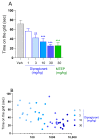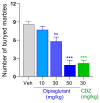Effect of the Metabotropic Glutamate Receptor Type 5 Negative Allosteric Modulator Dipraglurant on Motor and Non-Motor Symptoms of Parkinson's Disease
- PMID: 37048075
- PMCID: PMC10093229
- DOI: 10.3390/cells12071004
Effect of the Metabotropic Glutamate Receptor Type 5 Negative Allosteric Modulator Dipraglurant on Motor and Non-Motor Symptoms of Parkinson's Disease
Abstract
Parkinson's disease (PD) patients suffer not only from the primary motor symptoms of the disease but also from a range of non-motor symptoms (NMS) that cause disability and low quality of life. Excessive glutamate activity in the basal ganglia resulting from degeneration of the nigrostriatal dopamine pathway has been implicated in the motor symptoms, NMS and dyskinesias in PD patients. In this study, we investigated the effects of a selective mGlu5 negative allosteric modulator (NAM), dipraglurant, in a rodent motor symptoms model of PD, but also in models of anxiety, depression and obsessive-compulsive disorder, all of which are among the most prevalent NMS symptoms. Dipraglurant is rapidly absorbed after oral administration, readily crosses the blood-brain barrier, and exhibits a high correlation between plasma concentration and efficacy in behavioral models. In vivo, dipraglurant dose-dependently reduced haloperidol-induced catalepsy, increased punished licks in the Vogel conflict-drinking model, decreased immobility time in the forced swim test, decreased the number of buried marbles in the marble-burying test, but had no effect on rotarod performance or locomotor activity. These findings suggest that dipraglurant may have benefits to address some of the highly problematic comorbid non-motor symptoms of PD, in addition to its antidyskinetic effect demonstrated in PD-LID patients.
Keywords: Parkinson’s disease; anxiety; depression; dipraglurant; mGlu5; obsessive-compulsive disorder.
Conflict of interest statement
J.S.P., J.-P.R., R.L. and M.K. are currently employed by Addex Therapeutics. M.P.E.-J., F.G., A.-S.B., V.M., F.D., A.B., B.M., S.B. and S.P. were employees of Addex Therapeutics when the studies were conducted.
Figures





References
-
- Barone P., Antonini A., Colosimo C., Marconi R., Morgante L., Avarello T.P., Bottacchi E., Cannas A., Ceravolo G., Ceravolo R., et al. The PRIAMO study: A multicenter assessment of nonmotor symptoms and their impact on quality of life in Parkinson’s disease. Mov. Disord. 2009;24:1641–1649. doi: 10.1002/mds.22643. - DOI - PubMed
-
- Richard I.H. Anxiety disorders in Parkinson’s disease. Adv. Neurol. 2005;96:42–55. - PubMed
Publication types
MeSH terms
Substances
LinkOut - more resources
Full Text Sources
Medical

